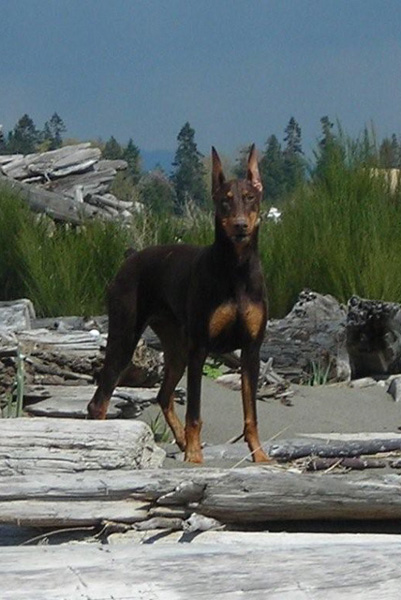If you have purchased a Doberman as a pet and then decide to breed it; first ask yourself, why, when there are so many Dobermans being born at this time, do you want to breed your own? If you want a puppy from a beloved pet, it would be cheaper to buy one that is like it - as your dog's offspring will not necessarily be like itself. If you are interested in getting a puppy whose breed quality is better than one you have now, it is frequently best to buy one and be sure of what you are getting. Are you objective enough to decide whether your dog is such that breeding it would contribute to the improvement of the breed if properly bred? Animals used for breeding should have a stable temperament - neither overly shy or overly aggressive. A Doberman used for breeding must be a good representative of the breed. This means, for example, it should have the proper number of teeth and be a proper color. Some colors such as white are not recognized in the breed and are a disqualification. To thoroughly familiarize yourself with the breed's requirements, a copy of the standard, entitled The Doberman Pinscher Illustrated (a 40 page illustrated discussion of the Doberman Pinscher breed standard) can be obtained from the DPCA Educational Materials Secretary.
Is your dog free of hereditary defects and are you familiar with these problems that occur in the breed (as well as many other breeds) such as: cardiomyopathy, cervical vertebral instability (CVI), Von Willebrands disease (VWD) and hip dysplasia? Are these defects in your dog's background or present in your dog?
Think of the cost of breeding. A litter of just six puppies, raised to the age of three months, given the best of care, can easily cost the breeder up to $3,000.00 or more! Consider the costs of: examination of the female before breeding (expenses would include x-rays for hip dysplasia, OFA certificate, worm check, brucellosis test, booster immunizations, VWD test, thyroid test, and health certificate); stud fee; possibly shipping to the stud (average 500 mile radius); extra food and vitamins for the female when six weeks in whelp; postpartum check for the female; tail docking/dewclaw removal; puppy immunizations (three series each); ear cropping; food and vitamins for the puppies before and after weaning and worming at least twice. Add the cost of a possible Caesarian section and the expense rises. This does not include problems which might occur with the dam or puppies, nor does it include the cost of advertising for puppies not sold. Thinking of cutting corners because the cost is so high? If the puppies and dam are not given the best possible care, you might have a litter of puppies sick or dead from Corona or Parvo viruses or puppies that develop hip dysplasia at two years of age.
Do you know enough about the Doberman Pinscher to breed at this time, or would it be better to learn more, look at more Dobermans and talk to more experts before breeding? Are you ready for the responsibility of being a breeder? Ethically, whether you own a bitch or male, you are responsible for all of the dogs you produce for their entire lifetimes.
Additional information to help you decide whether or not you are ready for the responsibilities of breeding may be obtained from Laurie E. Hanahan, 34294 Bridgestone Lane, Bluemont, VA 20135-1933.
Phone: 540-554-8636
Email: Ihanahan@mindspring.com
